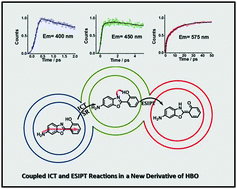An abnormally slow proton transfer reaction in a simple HBO derivative due to ultrafast intramolecular-charge transfer events†
Abstract
We report on the steady-state, picosecond and femtosecond time-resolved studies of a charge and proton transfer dye 6-amino-2-(2′-hydroxyphenyl)benzoxazole (6A-HBO) and its methylated derivative 6-amino-2-(2′-methoxyphenyl)benzoxazole (6A-MBO), in different solvents. With femtosecond resolution and comparison with the photobehaviour of 6A-MBO, we demonstrate for 6A-HBO in solution, the photoproduction of an intramolecular charge-transfer (ICT) process at S1 taking place in ∼140 fs or shorter, followed by solvent relaxation in the charge transferred species. The generated structure (syn-enol charge transfer conformer) experiences an excited-state intramolecular proton-transfer (ESIPT) reaction to produce a keto-type tautomer. This subsequent proton motion occurs in 1.2 ps (n-heptane), 14 ps (DCM) and 35 ps (MeOH). In MeOH, it is assisted by the solvent molecules and occurs through tunneling for which we got a large kinetic isotope effect (KIE) of about 13. For the 6A-DBO (deuterated sample in CD3OD) the global proton-transfer reaction takes place in 200 ps, showing a remarkable slow KIE regime. The slow ESIPT reaction in DCM (14 ps), not through tunnelling as it is not sensitive to OH/OD exchange, has however to overcome an energy barrier using intramolecular as well as solvent coordinates. The rich ESIPT dynamics of 6A-HBO in the used solutions is governed by an ICT reaction, triggered by the amino group, and it is solvent dependent. Thus, the charge injection to a 6A-HBO molecular frame makes the ICT species more stable, and the phenol group less acidic, slowing down the subsequent ESIPT reaction. Our findings bring new insights into the coupling between ICT and ESIPT reactions on the potential-energy surfaces of several barriers.


 Please wait while we load your content...
Please wait while we load your content...